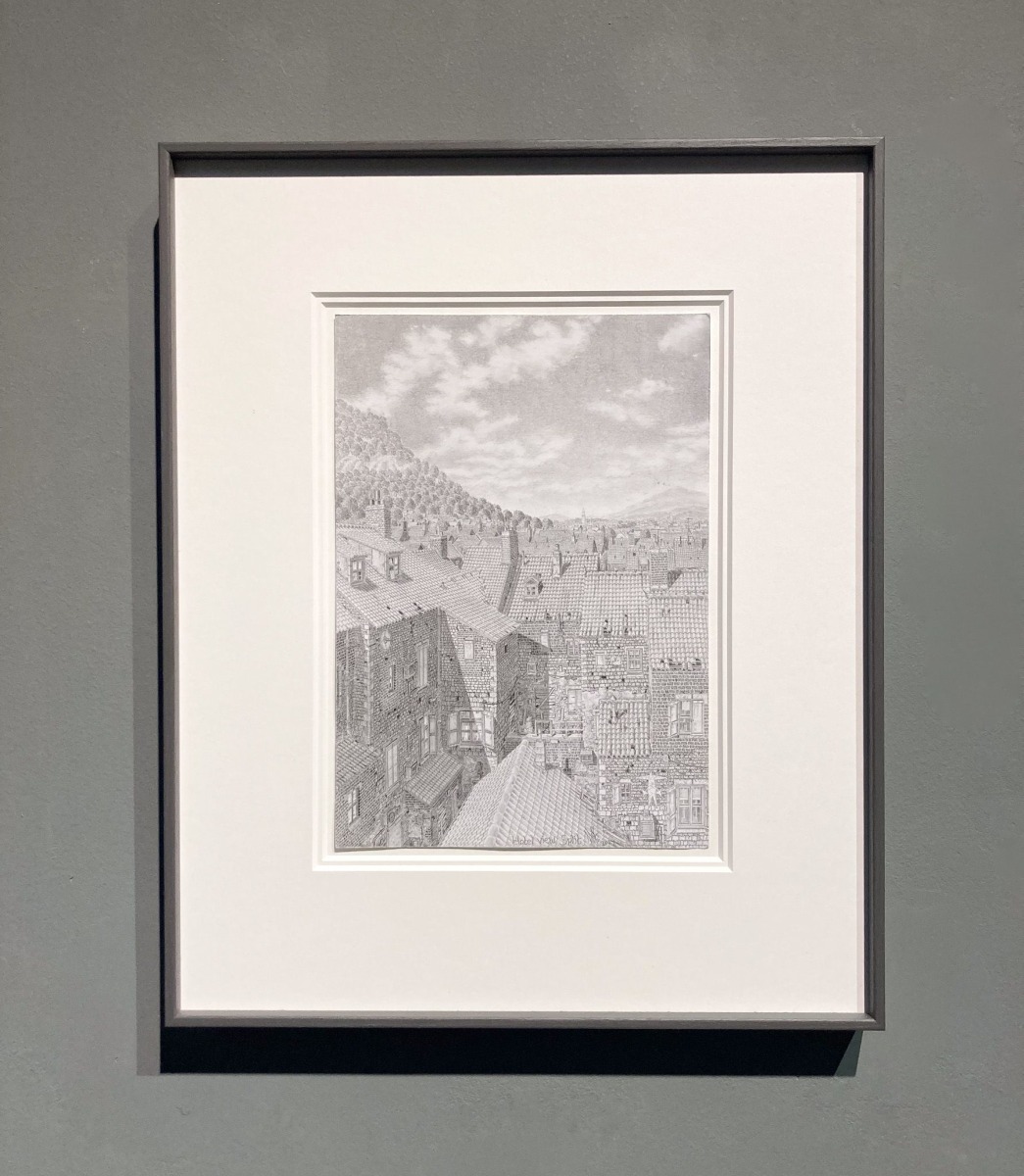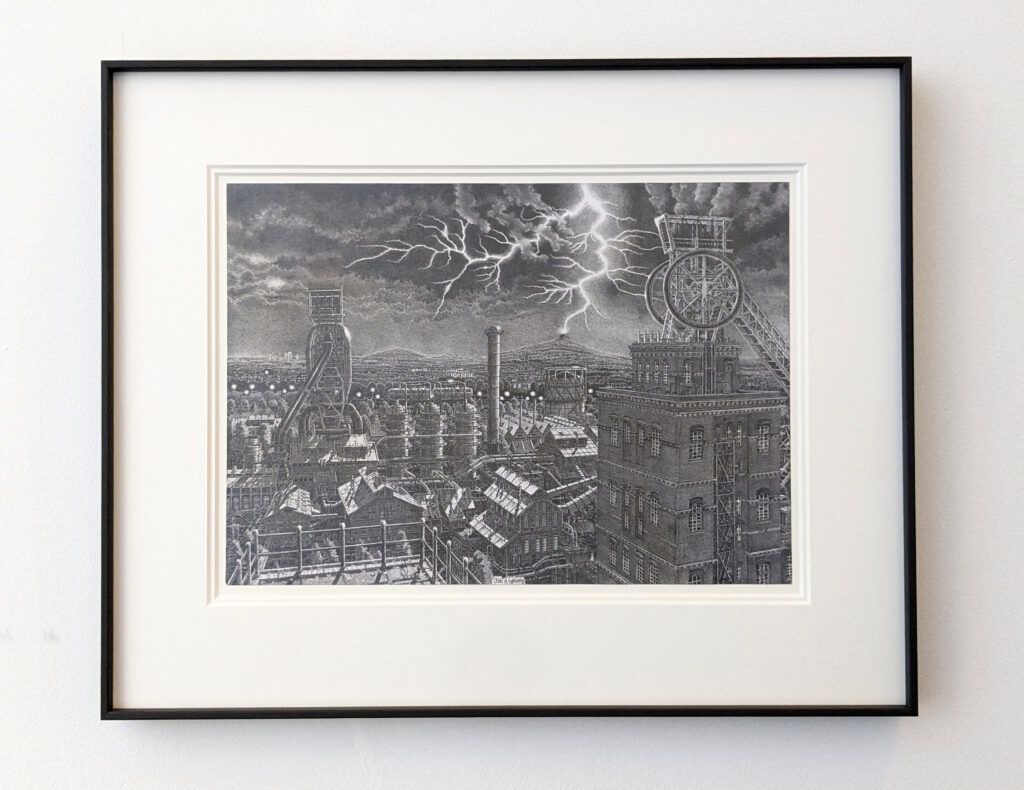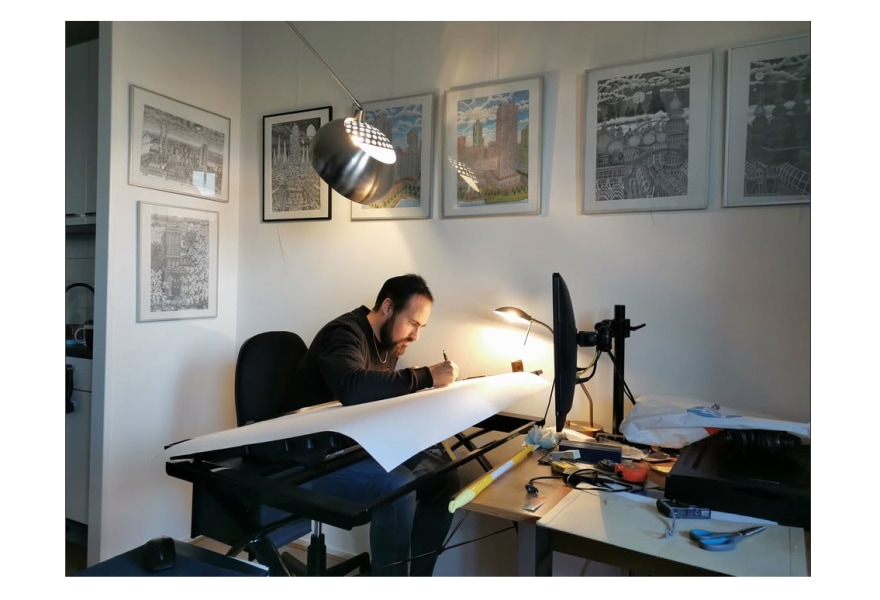16 december 2024, Wouter van den Eijkel
The studio of... Tim ter Wal
Tim ter Wal calls himself a ‘detail artist’ and that’s no exaggeration, as anyone who has seen his drawings of industrial complexes and cityscapes would agree. Ter Wal meticulously works out every detail. “Every detail you see in your daily surroundings, as well as what you find in a building or landscape, must be fully represented in a drawing.”
The self-taught artist executes this with a steady hand. Everything you see in his work is drawn without using a ruler, compass or stencil, and entirely from memory. The result is meticulously detailed drawings that invite endless observation, with a new detail catching your eye each time.
Tim ter Wal's solo exhibition can be seen at the Untitled Gallery in Rotterdam until 19 January.
Where is your studio and how would you describe it?
My studio is simply at home in my apartment in Almere. I have a special adjustable drawing table where I work, but other than that, it’s a fairly simple space where I focus on my drawings.
What does a typical workday look like? Do you have routines, play music or prefer silence? Do you welcome visitors or work for hours on end in complete concentration?
I generally spend about eight hours a day working on my drawings. I always have soft music playing in the background, which helps me concentrate fully. On the days I draw, I rarely have visitors. My workdays can vary a bit though. When the weather’s nice, I like to go out to a park or forest to clear my head and find new inspiration while walking. While drawing, I regularly take short breaks of about 15 minutes, which helps me stay focused for another hour or so.

Tim ter Wal, Winter sun forest, 2024, Gallery Untitled
Congratulations on your solo exhibition at Untitled Gallery! In the press release, you call yourself a ‘detail artist’. Anyone who sees your drawings immediately understands why. When did you realise you could capture every detail in your drawings?
As a child, I was extremely focused on certain buildings, landscapes and objects. I wanted to capture all these things on paper as detailed as possible, even back then. I developed my drawing skills entirely on my own, making me 100% self-taught. Every detail you see in your daily surroundings, as well as in a building or landscape, has to be fully represented in a drawing.
What pencils do you use and why these specifically?
I use an HB mechanical pencil with a 0.5-millimeter lead. I also use various regular graphite pencils of different grades to achieve the right contrast in my work. All my drawings are made entirely using a standard grey pencil.

Tim ter Wal, Hotel View Split, 2024, Gallery Untitled
I read that you work without rulers, templates or compasses. What’s your secret?
That’s right, all my drawings come entirely from my steady hand. Since I taught myself to draw this way, I can control my hand well enough to draw perfectly straight lines without a ruler. While drawing, I gradually bring out the contours by hand, ensuring that the perspective as a whole is correct. It’s not really a secret; I simply don’t know any other way to draw on paper.
Apart from cityscapes, there are also drawings of factories in your exhibition. What attracts you to these?
As a child, I was deeply fascinated by industry. Lots of factories have large and imposing buildings. Chimneys, pipelines and conveyor belts that are often found in large industrial sites are eye-catching elements with endless details, providing me with endless inspiration to draw them. Architecture captivates me in a similar way. As a child, I dreamed of becoming an architect, but I ultimately decided to focus fully on drawing.

Tim ter Wal, Otlab in Lightning, 2024, Gallery Untitled
Your work is quite unique; not many people can draw with this level of detail. Are there any artists you feel connected to?
I own a book by Escher. Like me, he had an eye for the smallest details, which he incorporated into his surrealism. His completely unique style, unmatched by any other artist, really speaks to me. Similarly, I’ve developed my own style, partly because I’ve never taken a class or had formal training.
Is there an existing space you’d like to draw someday?
Although I create everything purely from my imagination, I often find inspiration in real places. TATA Steel (formerly Hoogovens in IJmuiden) and Chemelot in Geleen are my greatest sources of inspiration. As far as existing locations are concerned, I’m fascinated by Split in Croatia. The old city centre, with its numerous historic buildings and signs of slight decay, really intrigues me. This has inspired several drawings of the city.
What are you currently working on?
At the moment, I’m working on a cityscape inspired by a small town on the Italian island of Sicily.

Tim ter Wal, Behind the Window, 2024, Gallery Untitled
